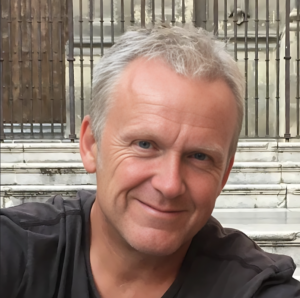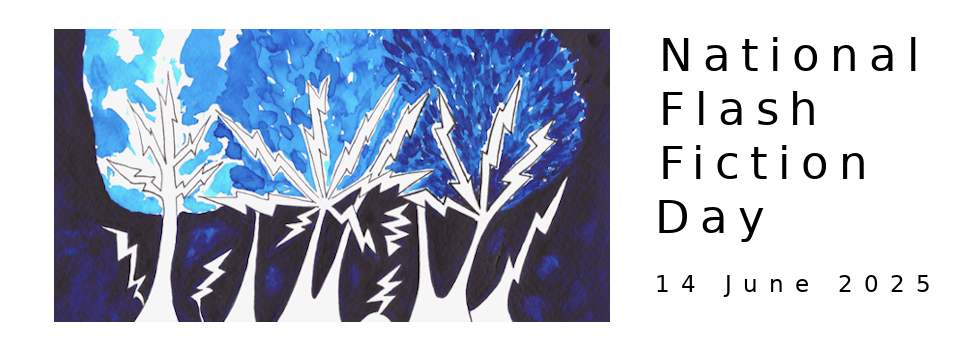Welcome to the fourth in our series of interviews with this year's National Flash Fiction Day Anthology Editors and Microfiction Competition Judges! Submissions for the Anthology and Microfiction Competition are open until 15 February 2024 and we'll be posting weekly interviews over the next couple weeks.
This week, NFFD's Diane Simmons chats with David Rhymes, one of this year's NFFD Microfiction Competition Judges, about everything from Novella-In-Flash inspiration, life in Spain, and his advice to those entering the Microfiction Competition....
 DS: Thank you for agreeing to be a micro fiction judge. Writing a hundred-word flash can be challenging. Do you have any advice for entrants to the competition or anything that you particularly like to see in a micro (or not see)?
DS: Thank you for agreeing to be a micro fiction judge. Writing a hundred-word flash can be challenging. Do you have any advice for entrants to the competition or anything that you particularly like to see in a micro (or not see)?
DR: Thank you for inviting me. I'm really excited and honoured to take part.
Regarding a successful micro, I agree with Tim Craig's comment last year that you need to "get in late, leave early." One way to achieve this might be to jolt the reader awake with your first line –
- 'I'm a combi boiler, hot at the touch of a button.' (Alison Woodhouse)
- 'She has heard that you can mould children, like clay' (Gaynor Jones)
- The GIs puff like bánh bao dumplings and drink until their pockets leak. (Sara Hills)
You only have 100 words, so you are going to need to make everything earn its keep – the title, the diction, the arrangement of words on the page, but also their suggestion and/or implication. The subtext if you like.
I particularly love stories that hint via suggestion at a larger world, invoking or nodding towards currents of history. Sara Hills' "Neil Armstrong Walks on the Moon" is a fabulous example of this. We get glimpses of America in Vietnam, the US space programme, but it comes wrapped inside the story of a mother explaining the world to her son, engaging in a kind of magical or wishful/ironical thinking. So we get the global echo, but also a highly specific portrait of a character-in-time-in-action – all this in just 100 words.
DS: Your novella-in-flash The Last Days of the Union was published by Ad Hoc Fiction in 2022. Can you tell us a little about the novella and what inspired you to write it?
DR: I was reading around the story of Mathias Rust, the young West German aviator who, in 1987, rented a Cessna sports plane and landed in Red Square, Moscow. He was hoping to speak to Mikhail Gorbachev about peace.
I thought, “What about a historical novella-in-flash, based on the Rust story, in which the main protagonist, hardly features at all?" A "novella with a hole in it" so to speak – a story told with the main character absent, appearing only as a shadow shape, a kind of photo-negative – built only out of other peoples' testimonies.
The story changed shape once I discovered via research that Rust's role in effectuating regime change was much more significant than many histories acknowledge. The latter half of the novella explores this possibility, tracing how Gorbachev used the failure of national defences as an excuse to purge military opponents and move forward with an agenda for change.
DS: Are there any flash fictions that you remember made you laugh out loud? If not, are there any that have made you cry?
DR: I listened recently to a selection of poems by Simon Armitage on Audible and several made me splutter – "Hop in, Dennis" (about giving Dutch footballer Dennis Bergkamp a lift as a hitchhiker) for example – the bit about the wine gums, and also odd lines like, "a contortion of red and white, like Santa Claus in a badger trap." A lot of the poems in his "Seeing Stars" collection read like flash, but I think these boundaries are permeable– I find the debate about what's actually this and what's actually that a bit superfluous.
Crying. Hmmm. I can be very moved, but teary? Not all that often in truth. The last flash I can remember that really made me cry (like really cry) was "Handover notes" by Victoria Richards. This is still one of my all-time favourite pieces.
DS: Do you have a favourite author (of flash or any other form)?
DR: Yes. Hundreds. Too many to list.
DS: You live in Navarra, Spain. Do you have a favourite spot to visit in Spain? If so, what makes it special to you?
I've been living here in Navarra for over twenty years now, so it's as much my homeland really as anywhere else in the world. It's a place of huge contrasts, with the Pyrenees to the north, the hilly middle or mixed zone where I live and the flat south, la Ribera, watered by the Ebro. My village is a little way south of Pamplona, in a valley called Valdizarbe. This is a wine and wheat growing area, traversed by the Camino de Santiago (Way of St James.) At one end of the valley is the market town of Puente la Reina (pilgrims will know this place). The main street of the town leads down to a famous medieval bridge and this short stroll is possibly my favourite in the whole of Spain. There is a special quality to the light in early summer, the coolness of the shade, the bustle of the little shops and terraces as you approach the bridge - certainly that’s where I’ve felt happiest to be alive, just doing my shopping, drinking a vermouth, eating pintxos of a Saturday morning.
